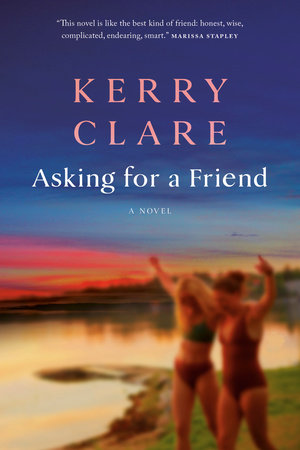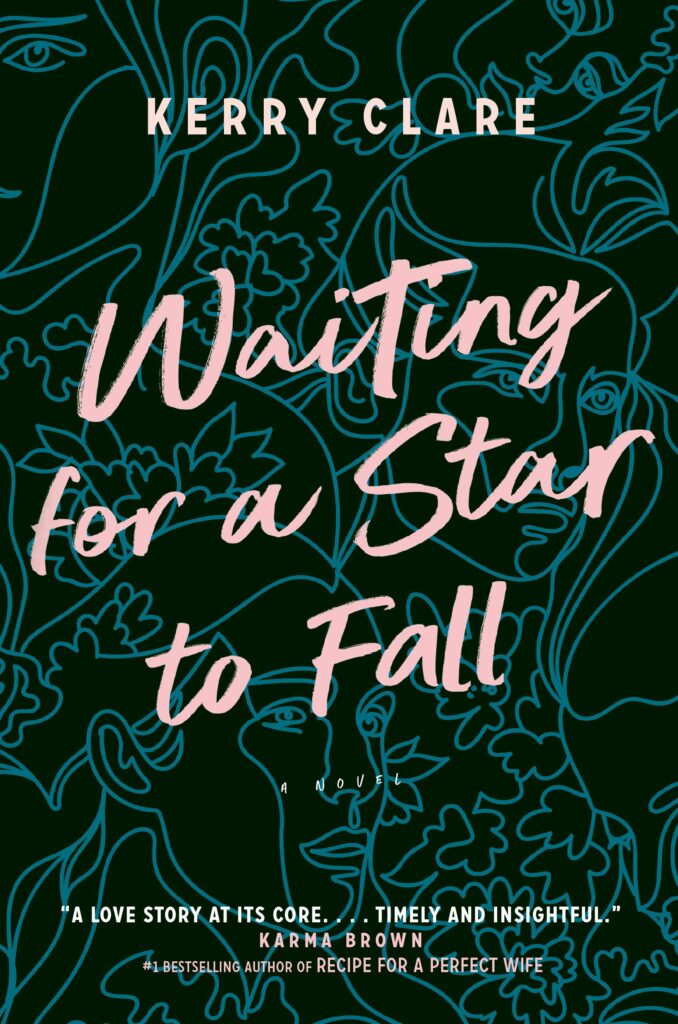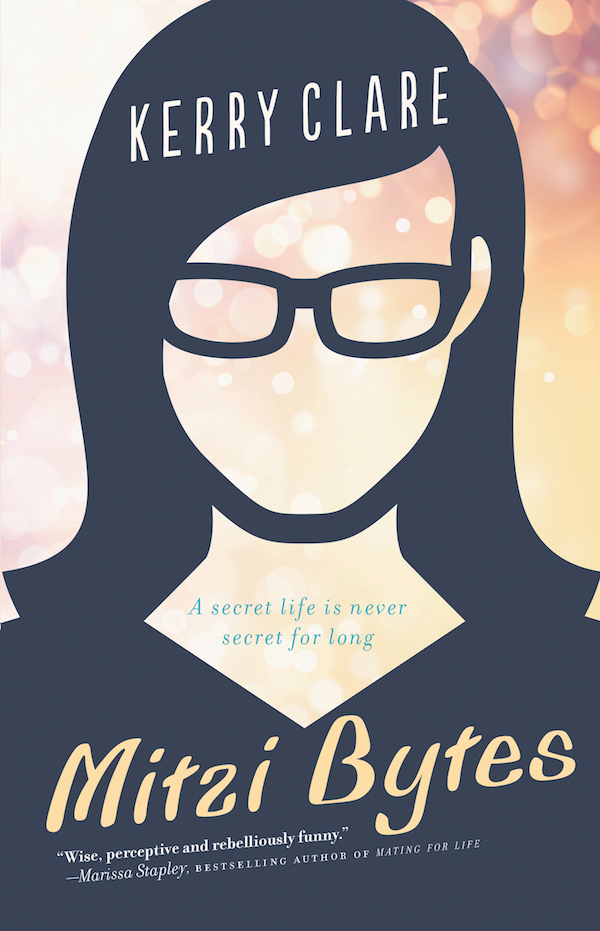November 3, 2010
Two old books: Quartet in Autumn by Barbara Pym and Anne of Windy Poplars by LM Montgomery
 Last week I read Barbara Pym’s Quartet in Autumn as I slowly (savouringly) make my way through her books. Quartet is the book Pym published after her years in the wilderness, the fifteen years where her work was considered unpublishable and her books went out of print. Her famous redemption came about in 1977 when Philip Larkin and Lord David Cecil both (independently) nominated her as one of the century’s most underrated writers. Quartet was published not long after that, followed by The Sweet Dove Died, which had been written previously and was rejected and rejected and then was not anymore.
Last week I read Barbara Pym’s Quartet in Autumn as I slowly (savouringly) make my way through her books. Quartet is the book Pym published after her years in the wilderness, the fifteen years where her work was considered unpublishable and her books went out of print. Her famous redemption came about in 1977 when Philip Larkin and Lord David Cecil both (independently) nominated her as one of the century’s most underrated writers. Quartet was published not long after that, followed by The Sweet Dove Died, which had been written previously and was rejected and rejected and then was not anymore.
Quartet is the story of four office mates (and what they do is quite beside the point. When the women retire, their positions aren’t filled. Days mostly hinge around brewing kettles and cups of tea) who are near retirement and who, through various circumstances, have each found themselves much alone in the world. And yet the four aren’t close either, which makes the story particularly interesting: what if the people who are closest to you hardly know you at all? And what if you’re fine with that?
Pym does a wonderful job of showing the discomfort of a person rather set in her ways who is forced to face a world that is changing. Though this makes for uncomfortable reading at times– I am not sure whether or not we’re meant to empathize with Letty when she leaves her flat because a family of Nigerians have moved into the unit below. Even Letty is not proud of her uncomfortableness, and I suppose this storyline is racist, but I also think it’s an honest depiction of very human situation. It’s not so much that Pym is racist, or her story is, though the character is, but that’s kind of the point. And I’m not sure that’s a good enough reason not to read the novel anymore.
Was hoarding a diagnosis in the 1970s? Because it’s all the rage these days, of course, but Letty’s co-worker Marcia was hard at it back in the day, filling the house she’d shared with her late mother with unopened packages of nightware from Marks and Spencer, stocking the cupboards with cans, and filling her garden shed with milk bottles (just in case there’s another war, and it’s the last war, where there was no milk without bottles). Pym manages to make Marcia’s affliction mildly amusing, actually, but it’s also sad. But not so sad– this is not a sentimental book. It’s not that lonely people are funny, or that funny people are lonely, but just that lonely people are, and I think it’s an idea that’s still incredibly profound.
**
 I just finished reading Anne of Windy Poplars, which I’d been meaning to do since Kate posted about it ages ago. It’s a strange novel, the fourth in the Anne series (between of the Island and House of Dreams), but it was written after all of them. I don’t think I’ve read this book in over twenty years, but I have recently read two biographies of Montgomery and so have a better idea of its context than I did the first time. That Montgomery was being pushed by her publishers to give her readers more Anne, and so a novel like this was sort of cobbled together. That she was also limited it what she could do with Anne in this in-between story, because certainly nothing too profound could happen to her that would have to be accounted for in her already-established later history.
I just finished reading Anne of Windy Poplars, which I’d been meaning to do since Kate posted about it ages ago. It’s a strange novel, the fourth in the Anne series (between of the Island and House of Dreams), but it was written after all of them. I don’t think I’ve read this book in over twenty years, but I have recently read two biographies of Montgomery and so have a better idea of its context than I did the first time. That Montgomery was being pushed by her publishers to give her readers more Anne, and so a novel like this was sort of cobbled together. That she was also limited it what she could do with Anne in this in-between story, because certainly nothing too profound could happen to her that would have to be accounted for in her already-established later history.
This novel takes place over three years in which Anne and Gilbert are living apart while she is working as principal of a high school in Summerside and Gilbert is studying at medical school. Much of the novel consists of letters she writes him, and I agree with Kate that these letters like nothing else express the true depth of their relationship. (Though unlike Kate, I never thought Gilbert was a dud. Perhaps that is because to me, he will always be Jonathan Crombie).
Because not much can happen to Anne then, this is an account of what happens to the people all around her– the people whose lives she touches, the curmudgeons she brings around, the wild people she manages to tame with her charm and by her wits. Some of these stories really are a bit much. We do see an Anne who is quite self-aware at times, and funny, remarking at one point of her tendency to meddle in the lives of others. This is less a novel really than a collection of episodes, almost short stories– it’s not so unlike The Blythes are Quoted in many respects, though of course Anne is much more central to what goes on. So many of the episodes are quite familiar to me from Anne of Green Gables: The Sequel which (please forgive me, and maybe I’m wrong because I’ve not seen it for a while) might be better than the book is. Which is not to say the book is bad, of course.
I had a similar problem with this book that I had with Budge Wilson’s Before Green Gables, with Anne encountering Anne-like characters. In Windy Poplars, it’s the story of Little Elizabeth, the lonely child who lives in the forbidding house next door and dreams of forever escaping into “tomorrow”– with all her talk of fairies and poetic trees, she’s like Anne Shirley on speed, and really, how can there be two of them? The whole point of Anne, her charm, is that she’s one in the million. Diana managed to be her kindred spirit while being nothing like Anne, and truth be told that dynamic made a lot more sense to me.
About Diana, a sad note in the novel– Anne goes home to Green Gables and Diana scarcely registers. She has a new baby, and Anne remarks at one point that Diana is busy in a whole other world, and that’s the end of it, but I found it disappointing. They were kindred spirits after all! Interesting also to see Montgomery locating her story in a wider context– there are mentions of boys, including Gilbert, going out west to work on “that railroad” they’re building out there. References to Anne teaching The War of 1812, and noting how lucky they were that days of war were far behind them, which was doubly not true by 1936 when the book was published.
October 14, 2010
On rereading What Maisie Knew
Well, I’ve been defeated. I reread Henry James’ What Maisie Knew, all prepared for that smug “I was so much stupider then, I’m starter than that now” feeling I often receive when I revisit a book I read in university. Because I remember really disliking Maisie when I read it back in Major British Novels or some such second year course, and how in our prof’s lecture notes, every fifth word was “ambiguous”, and I don’t know if I’d ever heard that word before, but by the end of the lecture I hated it. But I’m a better reader now, and I like everything else by Henry James I’ve ever read, and I read this after Room by Emma Donoghue to compare the children’s perspectives. But it just didn’t do it for me.
Of course, it’s not you, it’s me, I say to What Maisie Knew. And I really mean it– somewhere beneath these many-claused sentences, and multi-paged paragraphs, and so much explaining of just what I lost track, there is a really good novel here. The story of a young girl whose parents divorce and use her as a weapon against the other, and then the web is further tangled by step-parents, and other lovers, and a love-sick governess who refuses to do what she is told.
How much does Maisie know? Probably more than she’s meant to, but then I really don’t know. This novel required far more work than I was willing to offer in order to extract just what exactly was going on. Skip half a paragraph, and you’re lost, but reading the character carefully, word-for-word, I was still lost, so what was the point?
This is probably a really remarkable book, but I’m tired and have a head-cold.
October 3, 2010
On reading We Need to Talk About Kevin for the THIRD time
 I have determined that Lionel Shriver’s We Need to Talk About Kevin might be one of my all-time favourite books, because I’ve just read it for the third time in five years and devoured it as ravenously as I did the very first. That first time, I was blown away by Shriver’s twist at the end, which I never saw coming and totally stunned me. The second time, I read to discover whether the book would be as good if I knew what would happen, and it was, because I could pay attention to the details that rushed by me and meant little before I knew how things would unfold. This third time, I wanted to read it to see how realized her depiction of motherhood seemed now that I was a mother myself, however the answer to this question wasn’t quite what I came away with.
I have determined that Lionel Shriver’s We Need to Talk About Kevin might be one of my all-time favourite books, because I’ve just read it for the third time in five years and devoured it as ravenously as I did the very first. That first time, I was blown away by Shriver’s twist at the end, which I never saw coming and totally stunned me. The second time, I read to discover whether the book would be as good if I knew what would happen, and it was, because I could pay attention to the details that rushed by me and meant little before I knew how things would unfold. This third time, I wanted to read it to see how realized her depiction of motherhood seemed now that I was a mother myself, however the answer to this question wasn’t quite what I came away with.
What I’ve found most overwhelming about reading We Need to Talk About Kevin this time is what a fascinating narrator Eva is, her very unreliability so unreliable, or perhaps it’s not, which is the point. How this book is always framed in terms of the “issues” it addresses, but in strictly literary terms this is a phenomenal novel.
It’s not about motherhood, or maternal ambivalence, or school shootings. This is a novel about character, and how we present ourselves to the world, how we orchestrate our narratives. Eva being particularly privileged in this respect, as the novel is organized by letters she’s written to her estranged husband, and we have to consider what she chooses to present, to leave out. Does she have less control of the story than she seems too? Are we meant to be so much reading in between the lines, or is this precisely what she might have intended?
As much as the novel is about motherhood, I think it’s more about marriage. And though there is a coldness to Shriver’s novels, she is preoccupied as a writer with intimacy, with the domestic, with the closeness of married life. The dynamics between Eva and her son are far more straightforward than those between Eva and her husband– she presents him as such a doofus, but claims that he’s the love of her life. How could she love such a doofus? Or else, how could she present the man she loves with so little respect? Or maybe that’s just as much as Eva is capable of loving anyone, which puts her back at the centre of the story, the catalyst. Was Franklin the victim of what happened, or was his refusal to acknowledge the problem what only made it worse? She does suggest a framing where he is to blame. Were the family alliances different all along from what they seemed? Or is it just convenient for Eva to have us think this way? By the end of the book, Eva has somewhat redeemed herself as a mother and as a wife, but it’s interesting to question how much such redemption is just her own imposition. The ending she insisted on carving out of this tale.
This is the kind of novel you can come back to over and over again, but it will never just settle down and simply be one thing. It always just escapes one’s grasp. The plot is often boiled down to “nature versus nurture”, but such a simple dichotomy is just the beginning of what goes on. We Need to Talk About Kevin is a multi-headed beast, and I love that about it.
And yes, Shriver’s motherhood is spot-on in many places. As is her distinction between being a good mother and trying to be a good mother, and on the experience of motherhood as transformative or otherwise. I identified with Eva’s experience of failing to bond with her newborn child, which is so much the opposite of everything we’re set up to expect, and though my love grew with time, Kevin the monster baby was not always so far from my reality either. All of this testament to Shriver’s incredible imagination, which is evident in all her novels, as she imagines her way into the wholeness of a character’s life, the intricate details of how they spend their days.
Anyway, third time through it becomes clear to me what a truly “great” work this novel is, and I look forward to returning to it down the line to see what it’s become by then.
September 28, 2010
On rereading Nikolski
During Canada Reads 2010, I was championing the champion Nikolski, but of course I was a little bit concerned because I’d read the book two years before, and what it if had changed in the meantime? Because books do that, of course, or at least their readers do (which I had to discover with a great deal of nausea once the day I sat down to reread that once-beloved Priscilla Presley autobiography Elvis and Me, but that is another story). So I decided that I would reread Nikolski, to ensure that my championship remains appropriate, and it’s with a great deal of pleasure and relief that I can announce that it has. I will say, however, that it’s not a book that is necessarily better the second time around (as Lionel Shriver’s We Need to Talk About Kevin is, which is why I’ll be reading it for a third time in the next week or so) but it’s just as good, the prose just as rich, the text just as, um, textured. It’s a puzzle of a novel whose pieces fit together absolutely perfectly, the sum of its parts less remarkable than the fact of the summing itself, which is brilliant. In short, Nikolski is a book about books, the spells they cast, the paths they travel, and the paths they set us on.
September 2, 2010
Rereading A Memoir of Friendship
 The first time I read this book, I read it in a hammock, which makes me despair a bit at how much life is changed since then. Because we’ve moved, of course, and (seriously) the tree that hammock was hung from has since been chopped down, plus there is the matter of Harriet who is the very opposite of hammocks.
The first time I read this book, I read it in a hammock, which makes me despair a bit at how much life is changed since then. Because we’ve moved, of course, and (seriously) the tree that hammock was hung from has since been chopped down, plus there is the matter of Harriet who is the very opposite of hammocks.
The book is A Memoir of Friendship: The Letters Between Carol Shields and Blanche Howard, thirty years of correspondence between two writers (and wives, and mothers, and working women, and intellectuals, avid readers and dear friends). The first time I read it, it was with absolute joy, and I’ve been wanting to reread it for awhile since because I’ve read so many other books since and there will be all kinds of references I didn’t get the first time around. I was interested to see what newness was there.
I don’t know that I’ve ever loved rereading a book so much in my life. Even though I’ve only been reading it in dribs and drabs all summer long (usually while flossing and brushing my teeth, to be precise), because it’s long and I also wanted to savour it. The book makes its reader privy to the workings of two sharp, curious minds, to the trajectory of two different writing careers (and reading careers), to the trajectory of life in general (getting old is terrible, unfair and unrelenting. This book makes no bones about it. I admire the candour.) Privy also to little bits of gossip, literary and political. To the books they loved and the books they loved less, and also the reviewers that made their blood boil. Reading this book, one is privy to wisdom.
I made special note of the books Shields and Howard mutually appreciated, gushed over together, and have decided I want to make an effort to read this in the near future. They are:
The Home by Penelope Mortimer
The Odd Women by George Gissing
Parallel Lives: Five Victorian Marriages by Phyllis Rose
Anywhere But Here by Mona Simpson
Days and Nights in Calcutta by Clark Blaise and Bharati Mukherjee
Le Divorce by Diane Johnson
Mother Nature by Sarah Blaffer Hrdy
And though I’m not much of a crier when it comes to books, once again finishing this book had me weeping. I mean, so much so that it disturbed my daughter and she came over to try to make me laugh and deliver me a hug. To think of Shields dying and leaving a life and a world she so loved, and then to consider all those who loved her and would have to remake their lives without her. Somewhat selfishly, I also think of books unwritten. But I am also uplifted by a life that was so determinedly well-lived.
July 18, 2010
Rereading Still Life With Woodpecker by Tom Robbins
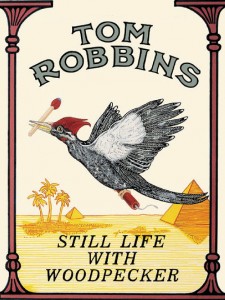 I’ll start with the fact that makes me want to die the least (honestly): I used to claim that all the wonderment of literature in general was contained within this one book, and if it was the only book left on earth, all the best things about literature would still remain. I am very glad I never was made to prove this.
I’ll start with the fact that makes me want to die the least (honestly): I used to claim that all the wonderment of literature in general was contained within this one book, and if it was the only book left on earth, all the best things about literature would still remain. I am very glad I never was made to prove this.
And then that I used to have a framed pack of Camel cigarettes hanging on my wall. I believed that it contained all the secrets of the universe, and would inspire me to be the kind of person I wanted to be.
That my copy of this book bears a heartfelt message from a boy who says he loves me. Which is really sweet, unless you know that I encountered him in an internet chatroom one day when I was very bored in 1999, and that we never met. (Though we did used to have discussions about how to make love stay, both agreeing ardently that when the mystery of the connection goes, love goes. However, we never did address how exactly the mystery of connection applies to two people who’ve never met.)
I think I’m less embarrassed about all that, however, than I am about the numerous lines throughout the text that I underlined in purple ink, in particular, “Me? I stand for uncertainty, insecurity, surprise, disorder, unlawfulness, bad taste, fun and things that go boom in the night.” Seriously, why did that speak to me? Because I only ever underlined things in purple ink if they resonated with my deepest being, but no one has ever stood for those things less than I do. Except bad taste. I think maybe it was aspirational…
So there are many ways to begin explaining just how much rereading Still Life With Woodpecker was an exercise in embarrassment. (And I reread this as part of Mark Sampson’s Retro Reading Challenge, I’ll have you know, of which embarrassment was sort of the point, but still, this must be unprecedented) I will explain that when I encountered this book, I was twenty years old and very bored, and that I was just contemplating turning my world upside down for the very first time. (The other line I fervently underlined during this period was from Tom Stoppard’s Arcadia [which I still love] which is: “This is the best time possible to be alive. When everything you know is wrong”).
Still Life… is the story of Leigh-Cheri, an exiled princess/all-American girl (like Anne Hathaway, but with more of a tendency toward unwanted pregnancies) who falls in love with a terrorist (and this was back when terrorism was still homey, domestic and romantic). Bernard is an “outlaw”, outside the law in every sense, except that he gets thrown back in jail, the couple drifts apart, her Arab fiance builds her a pyramid, the couple is reunited, and owe everything to a stick of dynamite. Bernard teaches Leigh-Cheri how to really be free, that love is crazy barking at the moon, that the moon is everything (including birth control), that sometimes you’ve got to throw caution to the wind, and blow a bunch of shit up.
When I read this book the first time, it gave me license to imagine I could live the kind of life I’d imagined. It made me feel more confident about going boldly forth, and making mistakes, and blowing shit up, and breaking the rules, and though I never did any of these things terribly prolifically (apart from the second), I am glad I learned these lessons when I was twenty years old. My life could possibly have been different otherwise, but I am not so sure I owe it as much to the Camel pack as I thought I did.
Rereading this book at 31, I see how far I’ve come, and how my literary judgement has sharpened, because the book is terrible. My political judgement has sharpened also– the Woodpecker is an anti-feminist, libertarian, but I would have noticed neither of these details then. Robbins’ prose is an orgy of play, but his language means nothing beyond its frippery, and it’s not even that funny– the only time I laughed out loud was when somebody sat on a chihuahua. I was bored reading most of it, and so bored out of my head by the end that I was only skimming. The sex was awful and gross, and not remotely sexy. The vagina euphemisms were totally disgusting, and I’m not sure why that didn’t put me off first time through.
I’m glad I reread it though– there were sparks of how brilliant I used to think it was. I don’t know if I’d ever read anything that interesting before, and it might have liberated me as a reader in the same way it did in a more general sense. And I wasn’t wholly cynical about its message. Even now, the idea of having CHOICE guide one’s life is very important to me: “To refuse to passively accept what we’ve been handed by nature or society, but to choose for ourselves. CHOICE. That’s the difference between emptiness and substance, between a life actually lived and a wimpy shadow cast on an office wall.” Rock on Tom!
Kind of inspiring, but not quite worth the 252 pages it took to get there.
July 11, 2010
Rereading Slouching Towards Bethlehem for the fifth time
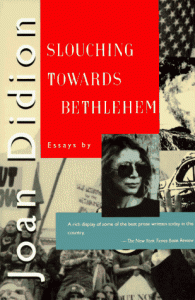 Rereading Slouching Towards Bethlehem for the fifth time, and it’s full of moments. First, my own moments– cracking the book open for the first time six years ago on a tram enroute to Miyajima, reading it again in 2008 after having been to California, that same rereading and the line from “On Keeping a Notebook”, “because I wanted a baby and did not then have one”, and rereading it again with the baby asleep in her room. It is like keeping a notebook, all the secrets this book holds about who I used to be, and it’s a different journey every time.
Rereading Slouching Towards Bethlehem for the fifth time, and it’s full of moments. First, my own moments– cracking the book open for the first time six years ago on a tram enroute to Miyajima, reading it again in 2008 after having been to California, that same rereading and the line from “On Keeping a Notebook”, “because I wanted a baby and did not then have one”, and rereading it again with the baby asleep in her room. It is like keeping a notebook, all the secrets this book holds about who I used to be, and it’s a different journey every time.
It’s curious that this is a book I can’t stop reading, a book that I long for when we’re parted too long. Because I like novels so very much, but this book of essays speaks to me in a way few novels ever have. Lucille Maxwell Miller and her volkswagen, and the fact of a man called Arthwell Hayton (who went on to marry the au pair, of course). The title essay, and a derailed social movement that Didion puts down to inarticulacy. The way she writes, the repitition and the cadences– her prose is music. Hypnotic. She describes “people of character”, which is a term we hear even less than when she hardly ever heard it anymore. “You see I want to be quite obstinate about insisting that we have no way of knowing– beyond that fundamental loyalty to the social code– what is “right” and what is “wrong”, what is “good” and what is “evil””– which underlines everything she writes, how she appears to just let the pieces fall where they may, her facts and stories speak for themselves, and they do. She’s the most uninstrusive omniscient narrator I’ve ever encountered.
And oh, she’s cool. Her California (you should read her memoir Where I Was From), and her Hawaii, where she is sent to in this book not in lieu of a divorce, but because she was a “recalcitrant thirty-one-year-old child” (as am I!). How she cried in Chinese laundries, and her golden curtains flew out the window and got drenched in the rain, and how the maid sulks when the wind blows (doesn’t she just?). The helicopter dropping the morning paper off on Alcatraz, and how she went to the grocery store in her bikini. And she spins and she spins and she spins– what a master.
I remember reading this book for the first time, and how it was nothing like what I had thought it would be, and how it was harder. To follow the circles of her arguments, to grasp the ungraspable (that things fall apart, the centre cannot hold). I remember how every time I read this book, I discover something new, and how it’s always summer. (“I imagine, in other words, that the notebook is about other people. But of course it is not.”)
June 25, 2010
A Spotlight on Atlantic Canada Reads
So yes, I’m rereading Lisa Moore’s February, and loving it as much as I loved it the first time, even though I was delirious back then. All of this very timely, because February is currently in the running for Atlantic Canada Reads, a brilliant initiative by Chad Pelley of (another brilliant initiative) Salty Ink (“a spotlight on Atlantic Canada writers”). Check out the other books up for Atlantic Canada Reads, and read their defenses, and vote for the book you think should take the prize.
March 17, 2010
Summer Summer Summer!
There are crocuses up in the garden across the street, and the sun was shining bright today. So bright so that I’ve got summer on the brain, even though it isn’t even spring until next weekend. But we’ve just booked our summer vacation, a cottage week away with a lovely lake almost at our doorstep, and I’m so excited for that.
I’m also excited about my summer rereading project. Every summer (except for last summer, during which a newborn was all the reading restriction I needed) I make a point of spending most of my time rereading all kinds of books, each for varying reasons. I’m already compiling this year’s stack– I want to revisit February by Lisa Moore (because of all the negative reviews I’ve read since, and I’m confused as to where they were coming from), Nikolski by Nicolas Dickner (to ensure it still stands up two years later), Small Ceremonies by Carol Shields (because because because), Anne of Windy Poplers by LM Montgomery (because of Kate), something early by Margaret Drabble (because I love her), Slouching Towards Bethlehem by Joan Didion (because I always do), and Still Life With Woodpecker (as part of the retro reading challenge).
September 30, 2009
Reporting from the reading road
So I’m halfway through Little Women, just beginning Part Two and Meg’s wedding. And what I do remember now from the first time I read this is that I was unbelievably confused about who Teddy and Laurie were, and only now do I realize that they were both Theodore Laurence. (And somehow I was also confusing him with Teddy Kent from Emily of New Moon, but that’s neither here nor is it there). In general, I’m not finding the book too rip-roaring, and am looking hungrily to my to-be-read stack and counting the number of pages left (250). But the experience is not without its joys: though the characters are types, they’re also more than a bit surprising, and Jo is as entrancing as Jo’s ever were. (Beth, however, I probably will not mourn so much when it’s time.) Regarding the types: remember Sarah Liss on Little Women as the original Sex and the City? I also absolutely love the self-consciously omniscient narrator.
It strikes me, however, that this is a children’s book in a way that anything penned by L.M. Montgomery is not. I’m revisiting this for the first time since girlhood, and I’m not finding anything new between the lines, unlike when I last reread Anne of Green Gables and discovered the heart of the story is actually Marilla. Also, Little Women is a bit too moralistic, which I realize is the whole point, but it’s sort of retchful, no? I know the girls don’t always manage to be good, but they’re always trying to, and Marmee is so frightfully good (because she’s suppressed her terrible temper) and I just feel as though the March family loves one another a little too much in order to compensate for… something.
So, is this sacrilege? What am I missing? Is this a book one has to fall in love with in childhood? Any illumination would be quite welcome.
UPDATE: Part Two has actually proved to be much more interesting. “Literary Lessons” (Jo’s adventures in publishing) laid out very clearly the confusing nature of writing feedback. And “Domestic Experiences” (where Meg and Brooke’s household descends into chaos when jelly fails to set is funny, poignant, and real). And even Amy’s failed posh fete. I am enjoying it more.
